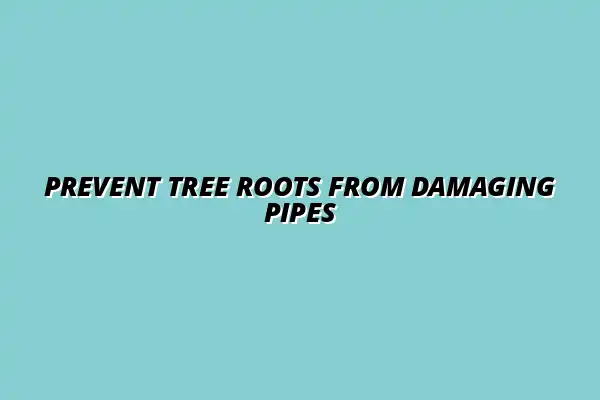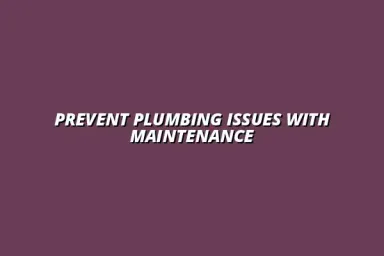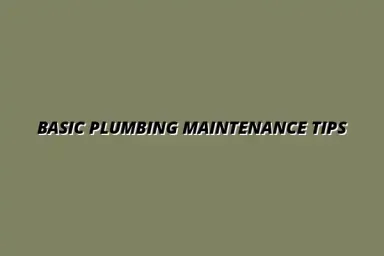Understanding Tree Roots and Their Impact on Plumbing Systems
Tree roots are often seen as a natural part of landscaping, but they can wreak havoc on plumbing systems if left unchecked. The roots grow in search of moisture and nutrients, which can lead them directly to your sewer lines and pipes. Understanding the relationship between tree roots and plumbing is crucial for homeowners looking to prevent expensive repairs and disruptions.
When tree roots enter plumbing systems, they can cause significant issues such as blockages and even structural damage to the pipes themselves. This infiltration can lead to slow drainage, backups, and costly repairs if not addressed promptly. Therefore, it's essential to recognize how these roots interact with your plumbing to take the necessary preventive measures. For more tips on preventing clogged drains, check out this helpful guide: Preventing Clogged Drains: Key Tips.
The Connection Between Tree Roots and Pipe Damage
Tree roots infiltrate sewer lines and pipes through tiny cracks and joints, causing blockages that can disrupt your entire plumbing system. As roots invade the pipes, they can grow and expand, leading to further damage. This growth creates pressure on the pipes, potentially causing them to crack or break. Understanding the causes of bursting water pipes is vital for preventative maintenance; learn more here: Causes of Bursting Water Pipes.
Moreover, the presence of moisture and organic matter within the pipes provides an ideal environment for roots to flourish. As the roots grow, they can obstruct the flow of waste and water, leading to backups that might require immediate attention. Preventing such damage is vital to maintaining a healthy plumbing system. Regular plumbing maintenance is key to avoiding costly repairs; find out more here: Plumbing Maintenance Tips for Homeowners.
- Roots can enter through small cracks and joints.
- The growth of roots puts pressure on pipes, leading to further damage.
- Moisture within pipes creates an inviting environment for root growth.
Common Signs of Tree Root Intrusion in Pipelines
Identifying the signs of tree root intrusion early can save you from extensive damage and costly repairs. One of the first symptoms often noticed is slow drainage from sinks, toilets, or bathtubs. This can indicate a potential blockage caused by roots in the pipes. Preventing clogs in your bathroom sink is crucial for maintaining a healthy plumbing system, see how here: Prevent Bathroom Sink Pipe Clogs.
Another common warning sign is frequent backups in your plumbing system. If you find yourself reaching for the plunger more often than usual, it may be time to investigate further. Other signs include unusual gurgling noises in pipes or unpleasant odors emanating from drains.
- Slow drainage in sinks and toilets.
- Frequent plumbing backups.
- Gurgling sounds in pipes.
- Unpleasant odors from drains.
Preventative Measures for Protecting Pipes from Tree Roots
Taking proactive measures to protect your plumbing system from tree roots is key to avoiding damage. Choosing the right trees for your landscape can significantly lessen the chances of root intrusion. It’s essential to research tree species that are known to be non-invasive and to plant them at safe distances from sewer lines. Maintaining a healthy bathroom sewer line is vital for your home's plumbing; learn more here: Healthy Bathroom Sewer Line Tips.
In addition to selecting the right trees, implementing physical barriers can also be an effective strategy. Regular maintenance practices, such as inspections and trimming, can further minimize risks to your plumbing system. For essential plumbing maintenance tips for your home, click here: Essential Plumbing Maintenance for Homes. Let’s take a closer look at these preventative measures.
Selecting the Right Trees for Your Landscape
When planting trees near your home, it’s crucial to choose species that are less likely to cause problems with your plumbing. Non-invasive trees typically have less aggressive root systems. To ensure safety, consider planting trees at a distance of at least 10 to 15 feet from sewer lines.
Some of the recommended non-invasive tree species include:
- Eastern Redbud
- Serviceberry
- Japanese Snowbell
- Flowering Dogwood
By strategically selecting and positioning trees in your yard, you can reduce the risk of root intrusion into your plumbing system.
Effective Root Barriers and Their Installation
Installing root barriers can help prevent tree roots from reaching your plumbing lines. A root barrier is typically a physical barrier made from materials such as plastic or metal, designed to redirect root growth away from critical areas. Proper installation involves placing the barrier vertically in the ground at a depth sufficient to block roots.
Here are some steps to consider when installing root barriers:
- Choose the right material for your root barrier.
- Determine the appropriate placement and depth.
- Secure the barrier firmly in the ground.
- Regularly check the barrier for effectiveness.
By taking these steps, you can ensure your plumbing lines remain safe from intrusive tree roots!
Regular Maintenance Practices to Prevent Root Damage
Regular maintenance is an essential part of preventing tree root damage to your plumbing system. Scheduling routine plumbing inspections can help identify potential issues before they escalate. Similarly, landscaping maintenance, including tree trimming and health checks, can reduce the likelihood of root intrusion. If you need a plumber in Billesley, Birmingham, you can find a reliable service provider here: Plumber in Billesley, Birmingham.
Additionally, homeowners should keep an eye on their drains and plumbing fixtures for any signs of trouble. If you notice unusual changes in drainage or hear strange noises, addressing these issues early can save you from bigger problems later on. Remember, an ounce of prevention is worth a pound of cure when it comes to protecting your plumbing!
Utilizing Root Killers and Other Chemical Solutions
In addition to physical barriers and regular maintenance, using root killers can be an effective method for managing tree roots. These chemical solutions are designed to eliminate unwanted roots within your plumbing system. However, it’s important to choose products that are safe for your pipes and the environment.
When using root killers, consider the following:
- Read and follow the application instructions carefully.
- Use products specifically designed for plumbing systems.
- Consider professional assistance if you're unsure how to proceed.
Incorporating root killers as part of your plumbing maintenance can help you stay ahead of potential root issues!
Restorative Actions Once Damage Has Occurred
Identifying and Repairing Damaged Pipes
First, it's critical to pinpoint where the damage has occurred in your plumbing system. Look for signs like foul odors, wet spots in your yard, or slow drains that could indicate tree roots are at fault. A thorough inspection often involves using a camera to see inside the pipes, which can help you identify the exact location and extent of the damage.
Once you've identified the problem, you can take steps to repair the pipes. Depending on the severity of the damage, consider the following options for repair:
- Pipe Cleaning: Use high-pressure water jets to clear out tree roots.
- Pipe Replacement: In severe cases, replacing sections of the pipe may be necessary.
- Trenchless Repair: This technique allows for less invasive repairs without digging up your yard.
Professional Services for Tree Root Removal
Sometimes the right solution is to call in the experts, especially if the tree roots have caused extensive damage. Knowing when to seek professional help can save you time and money. Look out for specific signs that indicate you should contact a professional:
- Recurring Blockages: If you experience frequent plumbing issues due to tree roots.
- Large Tree Roots: When the roots are too big for DIY removal methods.
- Pipe Damage: If you suspect your pipes are cracked or misaligned from root intrusion.
When hiring professionals for tree root removal, ensure they offer services such as root excavation, pipeline repair, and a detailed assessment of your plumbing system. Always check for proper licenses and read reviews to find a reliable service provider.
Long-Term Strategies for Maintaining Healthy Plumbing Systems
Integrating Landscaping with Plumbing Safety in Mind
It's essential to plan your landscaping with your plumbing system's health in mind. Some landscaping practices can significantly reduce the risk of tree root damage to your pipes. Here are some strategies you might consider:
- Choose the Right Plants: Opt for non-invasive plants that won’t aggressively seek out water sources.
- Careful Placement: Plant trees at a safe distance from sewer lines, generally at least 10 to 20 feet away.
- Regular Pruning: Keep trees trimmed to manage root growth and overall size.
These practices not only protect your plumbing but can enhance the beauty and value of your landscape, making it a win-win situation!
Establishing a Regular Maintenance Schedule
Creating a regular maintenance routine is vital for keeping both your trees and plumbing systems healthy. This can include a mix of inspections and preventive care. Here’s a simple schedule you might adopt:
- Quarterly Inspections: Check plumbing systems and tree health every three months.
- Annual Assessments: Hire professionals for a thorough inspection of your sewer lines and root systems.
- Seasonal Pruning: Trim trees in early spring or late fall to maintain healthy growth.
Regular maintenance not only prevents future issues but also provides peace of mind that your home is protected against unforeseen plumbing problems!
Summarizing Effective Approaches to Preventing Tree Root Damage
Key Takeaways on Protecting Your Pipes
To summarize, protecting your plumbing systems from tree roots requires a proactive approach. Here are the main points to remember:
- Choose non-invasive tree species and plant them away from sewer lines.
- Regularly inspect and maintain both landscaping and plumbing.
- Know when to seek professional assistance for tree root issues.
Encouraging Proactive Measures for Homeowners
As a homeowner, taking proactive measures can significantly reduce the risk of tree roots damaging your plumbing system. I encourage you to assess your property today! Look for potential risks and take the necessary steps to safeguard your plumbing systems against intrusive roots.

 Kiran Almasi
Kiran Almasi

